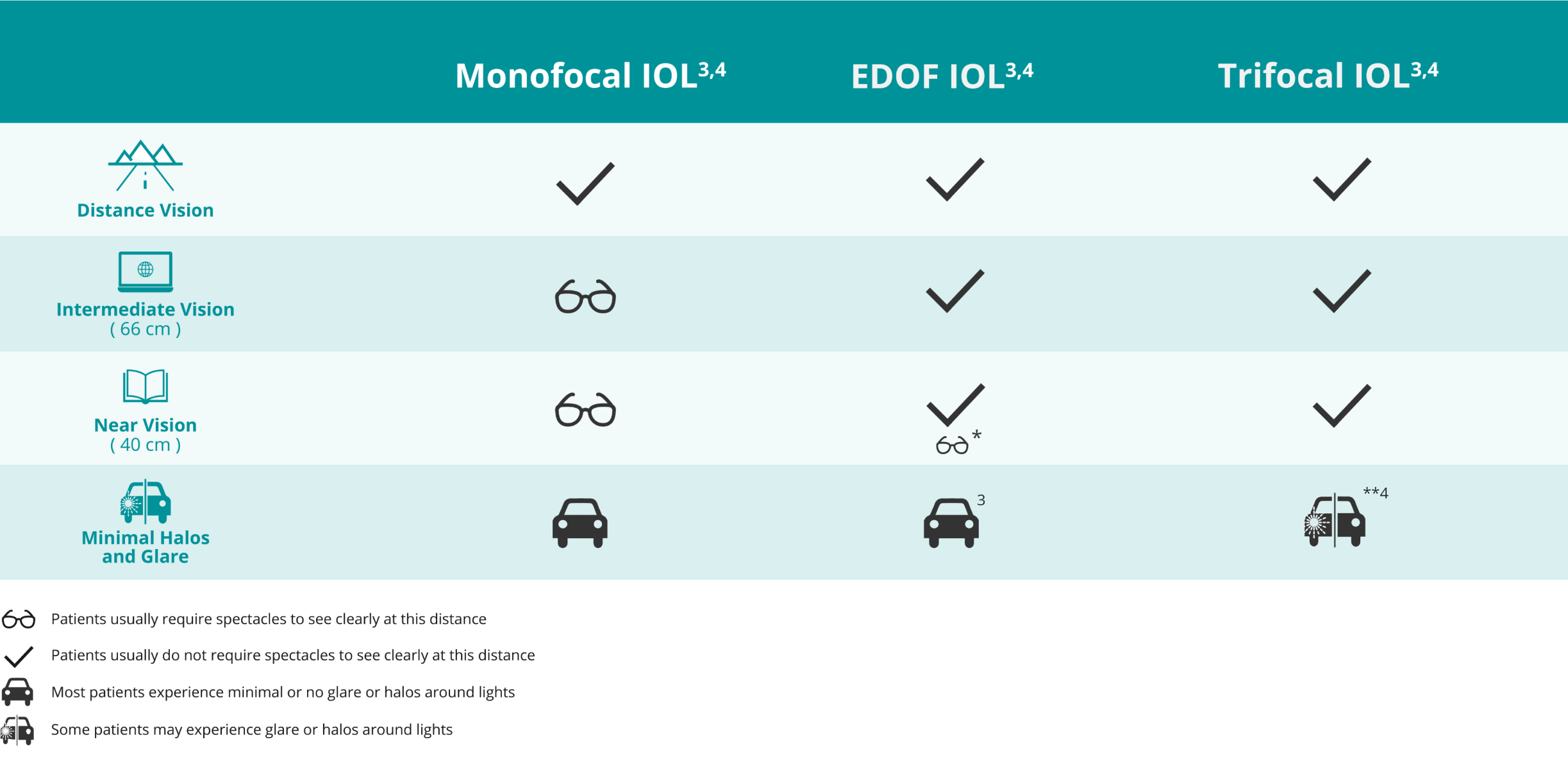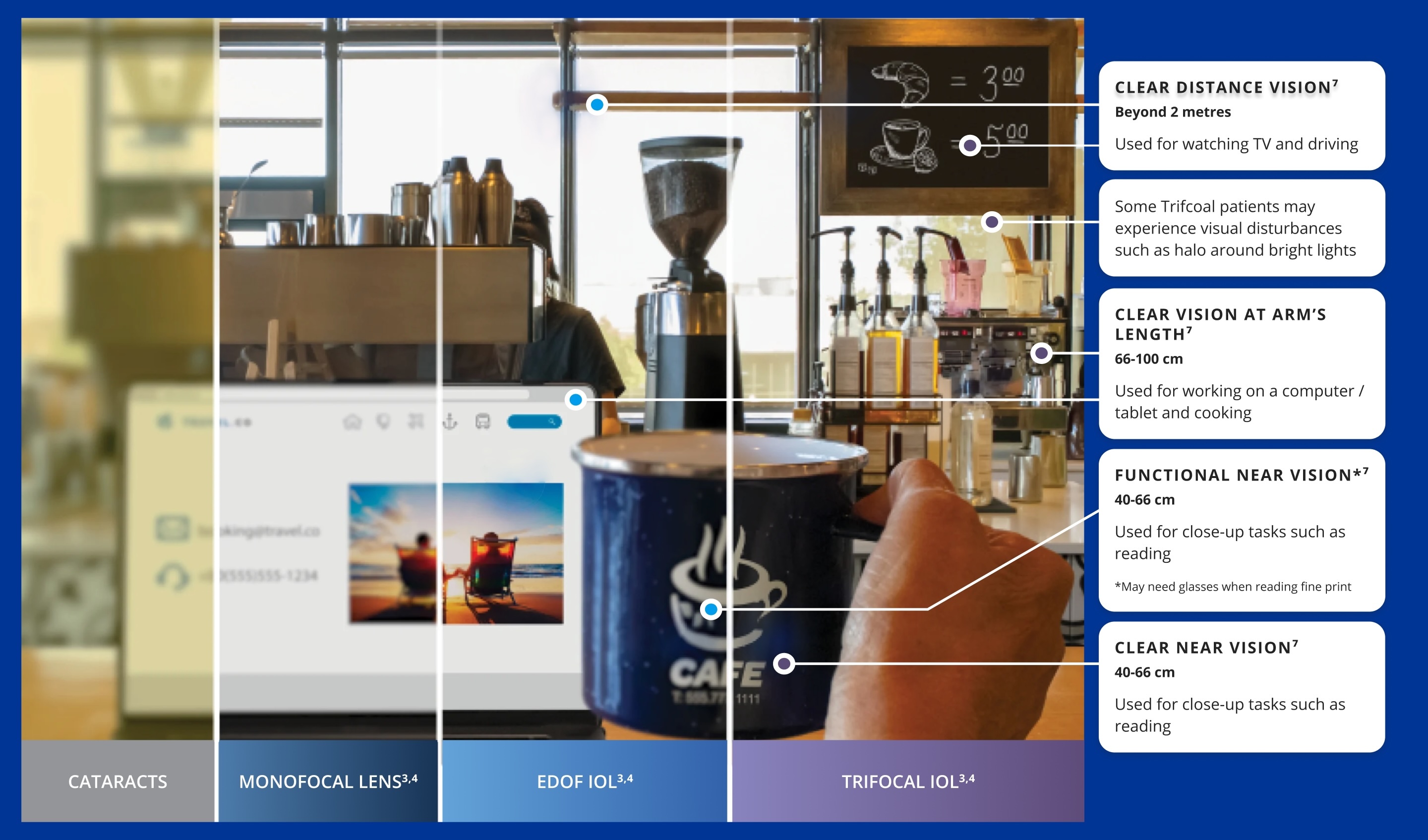What are cataracts?
A cataract is a clouding of the eye’s natural lens, making it difficult for light to enter your eye, as if looking out a foggy window.1
With cataracts, you may experience symptoms such as:
![]()
Blurred vision
![]()
Trouble seeing at night
![]()
Light and glare sensitivity
![]()
Seeing halos around lights
![]()
Fading or yellowing of colours
![]()
Double vision
![]()
Frequent changes to your vision precriptions

Are cataracts normal?
Cataracts occur naturally as you get older, developing gradually over time. The only way to treat cataracts is through cataract surgery.1
Since the onset of cataract symptoms is typically slow and gradual, many patients discover the beginnings of a cataract during a routine eye examination before they even notice any changes to their vision.
Intraocular lenses (IOLs) are used in cataract surgery to replace the natural lens of the eye. Extraction of a cataract and replacement with an IOL will require surgery and all surgeries carry risk. Please consult your eyecare professional to determine if this product is right for you. If you experience any symptoms, consult your eyecare professional as the symptoms may be a sign of other eye problems. Reduced dependence on spectacles is a potential secondary benefit of using IOLs – individual patient results may vary. This product is not available for purchase by the general public.
Should I worry about cataracts?

A Normal Part of Aging
Most people over 65 will
develop cataracts.

You Have Options
You have an important choice to make when it comes to the kind of vision you want after cataract surgery.


Highly Successful
Cataract surgery is one of the most
successful surgical procedures
of all time.2

Find a cataract surgeon near you
Use our cataract surgeon finder tool to locate a surgeon near you.

Download our discussion guide
Lead the conversation with your surgeon to understand the IOL choice that’s most suitable for you!
What kind of vision would you like after surgery?
Cataract surgery involves removing the natural lens in the eye that has become cloudy, and replacing it with an artificial lens (known as an intraocular lens or IOL).
Depending on the IOL you choose (in conjunction with your surgeon), cataract surgery may also help you become less dependent on glasses, or even spectacle-free.3,4,5 It’s important to discuss your IOL options with your surgeon prior to surgery to ensure you receive the IOL most suited to your needs.
Intraocular lenses (IOLs) are used in cataract surgery to replace the natural lens of the eye. Extraction of a cataract and replacement with an IOL will require surgery and all surgeries carry risk. Please consult your eyecare professional to determine if this product is right for you. If you experience any symptoms, consult your eyecare professional as the symptoms may be a sign of other eye problems. Reduced dependence on spectacles is a potential secondary benefit of using IOLs – individual patient results may vary. This product is not available for purchase by the general public.
Intraocular lenses (IOLs) are used in cataract surgery to replace the natural lens of the eye. Extraction of a cataract and replacement with an IOL will require surgery and all surgeries carry risk. Please consult your eyecare professional to determine if this product is right for you. If you experience any symptoms, consult your eyecare professional as the symptoms may be a sign of other eye problems. Reduced dependence on spectacles is a potential secondary benefit of using IOLs – individual patient results may vary. This product is not available for purchase by the general public.
Take a closer look at your vision options6

Monofocal / Toric IOLS
These IOLs (otherwise known as single-vision lenses) are ideal for people requiring excellent distance vision who don’t mind wearing glasses for reading up close or working on their computer.3,4

Extended range of vision IOLs
Extended range of vision IOLs are for those who would like good distance and intermediate vision and don’t mind wearing glasses for extended periods of close work.3,4

Trifocal IOLs
Trifocal IOLs, also known as multifocal, provide clear vision for long distances as well as nearer tasks like reading.3,4 However, not everyone is suitable for Trifocal IOLs so it’s important to talk to your opthalmologist to see which IOL will work best for your needs.

*Some EDOF patients may find tasks like reading fine print are improved by wearing glasses
**Some Trifocal patients may experience visual disturbances such as a halo around bright lights
Intraocular lenses (IOLs) are used in cataract surgery to replace the natural lens of the eye. Extraction of a cataract and replacement with an IOL will require surgery and all surgeries carry risk. Please consult your eyecare professional to determine if this product is right for you. If you experience any symptoms, consult your eyecare professional as the symptoms may be a sign of other eye problems. Reduced dependence on spectacles is a potential secondary benefit of using IOLs – individual patient results may vary. This product is not available for purchase by the general public.
What happens during cataract surgery?
Did you know that cataract surgery is a routine, day-surgery procedure that lasts less than 30 minutes?
During surgery, your surgeon will replace your cataract with an IOL
You will receive local anaesthetics to numb the area around your eye or a sedative to help you relax.6

Recovery after cataract surgery is usually very quick
Within a few days most patients can return to their daily activities, with vision improving over time.6

After surgery, your surgeon will monitor the healing process
Eye drops may be prescribed to prevent infection or reduce inflammation. Patients usually see their ophthalmologist a day or two after surgery, the following week, and then again after one month.6

Intraocular lenses (IOLs) are used in cataract surgery to replace the natural lens of the eye. Extraction of a cataract and replacement with an IOL will require surgery and all surgeries carry risk. Please consult your eyecare professional to determine if this product is right for you. If you experience any symptoms, consult your eyecare professional as the symptoms may be a sign of other eye problems. Reduced dependence on spectacles is a potential secondary benefit of using IOLs – individual patient results may vary. This product is not available for purchase by the general public.
Compare the images below to discover which IOL type may be suitable for you!
This image guide has been designed to provide patients considering cataract surgery with a better understanding of their intraocular lens (IOL) options. The post-operative images presented have been developed using the results from clinical studies involving patients implanted with the lens presented. However individual patient results may vary and these images are for illustration purposes only. This product is not available for purchase by the general public.
Speak to your eyecare
professional today about
your vision choices.
Intraocular lenses (IOLs) are used in cataract surgery to replace the natural lens of the eye. Extraction of a cataract and replacement with an IOL will require surgery and all surgeries carry risk. Please consult your eyecare professional to determine if this product is right for you. If you experience any symptoms, consult your eyecare professional as the symptoms may be a sign of other eye problems. Reduced dependence on spectacles is a potential secondary benefit of using IOLs – individual patient results may vary. This product is not available for purchase by the general public.
References:
1. National Eye Institute (NIH). Cataracts, November 2023. Available at: https://www.nei.nih.gov/learn-about-eye-health/eye-conditions-and-diseases/cataracts.
2. Laser Eye Surgery Hub. Cataract Statistics & Resources. Available at: https://www.lasereyesurgeryhub.co.uk/cataract-statistics/. Accessed August 20, 2018.
3. Mott M. A New Generation of IOLs. American Academy of Ophthalmology, Jan 2022. Accessed on November 2024; via https://www.aao.org/eyenet/article/a- new-generation-of-iols.
4. Saenz B, Lopez C, and Sepulveda R. Keeping Up with the Newest IOLs. Review of Optometry, Dec 2023. Accessed on November 2024; via https://www.reviewofoptometry.com/article/keeping-up-with-the-newest-iols.
5. terHorst C. American Academy of Ophthalmology (AAO). “Choosing an Artificial Lens for Cataract Surgery.” Available at: https://www.aao.org/eye-health/treatments/best-artificial-lens-IOL-cataract-surgery Accessed: November 1, 2021.
6. Mayo Clinic Staff. What you can expect [Cataract Surgery]. Mayo Clinic. July 30, 2013. Available at: http://www.mayoclinic.org/tests-procedures/cataract-surgery/basics/what-you-can-expect/prc-20012917. Accessed August 20, 2018.
7. Caltrider D, Gupta A, Tripathy K. Evaluation of Visual Acuity. [Updated 2024 May 1]. In: StatPearls [Internet]. Treasure Island (FL): StatPearls Publishing; 2024 Jan. REF-26825


